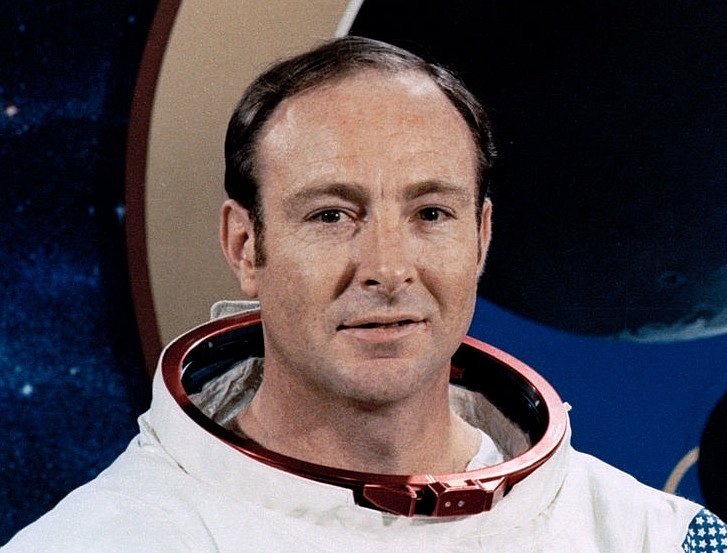Culture
Goodbye Edgar Mitchell: The Man Who Saw Earth And Space As One

When Edgar Mitchell went into space he had an inexplicable experience on seeing the Earth from there. He then asked himself some fundamental questions and eventually found their answer in the Indic knowledge system
When octogenarian Edgar Mitchell died on February 4, 2016, the field of space exploration lost another one of its pioneers. Mitchell was the sixth man to walk on moon. A member of the famous Apollo-14 crew, he also had a doctorate in aeronautical engineering.
More important than the landing on moon itself, Mitchell brought to Earth a powerful vision—the experience of witnessing Earth from space—a blue, living planet with no artificial boundaries. The experience of the sight of Earth in the context of the vastness of space created a transformation in his inner self. Returning from space, he searched through scientific literature then available for the experience he had had. Later, he explained in an interview:
“The experience in space was so powerful that when I got back to Earth I started digging into various literatures to try to understand what had happened. I found nothing in science literature but eventually discovered it in the Sanskrit of ancient India. The descriptions of samadhi, Savikalpa samadhi, were exactly what I felt: it is described as seeing things in their separateness, but experiencing them viscerally as a unity, as oneness, accompanied by ecstasy. (To Sarah E. Truman, editor of Ascent magazine)”
To understand the significance of this statement, one has to look at the kind of discourse that space exploration was creating in the popular culture of the times. In 1961, the then Soviet Supremo Nikita Khrushchev had proudly declared at the plenum of the Central Committee of the CPSU, that ‘Gagarin flew into space, but didn’t see any god there.’ It was in the support of their anti-religion campaign.
But if God is more a powerful transforming experience in consciousness, a sense of Absolute Unitary Being (AUB) than an external reality, then ten years after Soviet supremo ridiculed God, astronaut Edward Mitchell had an spiritual experience whose explanation he discovered in ancient Hindu sacred terminology.
Already the image of Earth from space had started stirring the human inner-universe tremendously. Commenting on the Apollo-8 image of Earth in space, mythologist Joseph Campbell has spoken of it as ‘telling image’, and as ‘the one oasis in all space, an extraordinary kind of sacred glove, as it were, set apart for the rituals of life ; … the entire globe now a sanctuary, a set-apart Blessed Place’.
Like all powerful mythological images, the experience of space vision has made its imprint on the collective psyche of our species and for that, Mitchell became the vehicle. Unfortunately, mainstream science as well as the institutions of science were then not equipped to deal with this vision. Mitchell had to dabble with the fringe groups – from UFO enthusiasts to para-psychologists. Beyond all these, he tirelessly championed the vision of one interconnected planet.
So what is his real legacy?
In the 1980s, the vision of Earth as a huge systemic web of life burst upon mainstream science and popular culture. And it took on the name of pagan earth Goddess – Gaia. The popular acceptance of Gaia despite reluctance on the part of mainstream scientists may be partly due to the popularization of the vision of Earth from space which Mitchell pioneered.
Institute of Noetic Sciences (IONS) that he founded in 1973, soon after his retirement from NASA, has today grown into a movement that dedicates itself to ‘a shift in consciousness worldwide, where people recognize that we are all part of an interconnected whole’. It may have looked mystical in 1970s but today the social and ecological implications of such a goal are explicit and down to earth.
Of course IONS also works in the field of parapsychology. Even the highly controversial parapsychology, often bundled with pseudo-sciences, has resulted in studies which have helped us to understand some lesser known aspects of consciousness. Hindol Sengupta in his ‘Being Hindu’ mentions the IONS and how they study the interconnected reality.
Seven years back writing in Newsweek, Lisa Miller made a critical observation that more and more Americans are today embracing the Hindu point of view of diverse faiths leading to a single reality. Edgar Mitchell definitely acted as catalyst in spreading this Hindu vision of universal planetary spirituality.
So, the importance of Edgar Mitchell is in showing us humans that what transforming the vision of space and our own place in it can be and what powerful experiences it can invoke in our brain already evolved with neural modules for spiritual experiences.
A great visit to planet earth between 1930 and 2016, good bye Edgar Mitchell…may you abide in the Brahman for this cosmic cycle.
Support Swarajya's 50 Ground Reports Project & Sponsor A Story
Every general election Swarajya does a 50 ground reports project.
Aimed only at serious readers and those who appreciate the nuances of political undercurrents, the project provides a sense of India's electoral landscape. As you know, these reports are produced after considerable investment of travel, time and effort on the ground.
This time too we've kicked off the project in style and have covered over 30 constituencies already. If you're someone who appreciates such work and have enjoyed our coverage please consider sponsoring a ground report for just Rs 2999 to Rs 19,999 - it goes a long way in helping us produce more quality reportage.
You can also back this project by becoming a subscriber for as little as Rs 999 - so do click on this links and choose a plan that suits you and back us.
Click below to contribute.
Latest